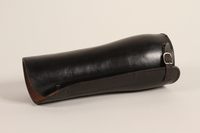Overview
- Brief Narrative
- Color poster of an iconic painting of the Fuhrer, Adolf Hitler, printed in Germany during the Third Reich, 1933-1945. The original painting was created by Heinrich Knirr in 1935-1936, and was based on a photograph taken by Heinrich Hoffman in 1935. Hitler approved the image and it was widely used on Nazi propaganda pieces and was very popular. The slogan Ein Volk, ein Reich, ein Fuhrer was one of the central slogans used by Hitler and the Nazi Party. Nazi propaganda portrayed their leader (Fuhrer) as the living embodiment of the German nation and people. This slogan reinforced the cult of Hitler and the sense of destiny that the Party claimed made him the savior of Germany and father of the German people.
- Artwork Title
- Ein Volk, ein Reich, ein Fuhrer!
- Alternate Title
- One People, one Country, one Leader!
- Date
-
publication/distribution:
approximately 1940
- Geography
-
manufacture:
Reichenbach (Saxony, Germany)
- Credit Line
- United States Holocaust Memorial Museum Collection
- Markings
- front, lower edge, Gothic font, white ink : Ein Volk- Ein Reich- Ein Fuhrer! [One People, one Country, one Leader!]
front, lower right corner, black ink : CARL WERNER, REICHENBACH i.V. [Reichenbach im Vogtland] - Contributor
-
Printer:
Carl Werner
Physical Details
- Language
- German
- Classification
-
Posters
- Category
-
Nazi propaganda
- Object Type
-
Posters, German (lcsh)
- Physical Description
- Offset color lithographic poster reproduction of a portrait painting of Adolf Hitler from the waist up, angled right, with his bent left arm on the back of a chair and the back of his right wrist, with his arm bent, elbow out, placed on his waist. He wears a brown uniform jacket with a red swastika armband on the left arm, a white shirt, and a brown tie with a gold Reichsadler pin. The background is dark red. Below the image is a wide black border with a rally slogan in white Gothic German font. The poster is adhered to the back of a reproduction of a darkly shaded townscape painting by Hans Hartig.
- Dimensions
- overall: Height: 23.625 inches (60.008 cm) | Width: 16.875 inches (42.863 cm)
- Materials
- overall : paper, ink, adhesive
Rights & Restrictions
- Conditions on Access
- No restrictions on access
- Conditions on Use
- No restrictions on use
Keywords & Subjects
Administrative Notes
- Legal Status
- Permanent Collection
- Provenance
- The poster was acquired by the United States Holocaust Memorial Museum in 2003.
- Funding Note
- The cataloging of this artifact has been supported by a grant from the Conference on Jewish Material Claims Against Germany.
- Record last modified:
- 2022-09-09 14:17:10
- This page:
- https://collections.ushmm.org/search/catalog/irn516176
Download & Licensing
In-Person Research
- By Appointment
- Request 21 Days in Advance of Visit
- Plan a Research Visit
- Request to See This Object
Contact Us
Also in Third Reich propaganda collection
The collection consists of a banner, a pair of gaiters, a poster, documents, publications, and prints relating to life in Germany under the Third Reich, from 1933-1945.
Date: approximately 1934-1965

Pair of black leather gaiters
Object
Pair of black leather half chaps which were worn with short boots to protect the lower legs, inscribed with a name and a German city. They are similar to gaiters made in 1920, but they are undated.
Long, white banner with the Nazi Party slogan Ein Volk - Ein Reich - Ein Fuhrer
Object
Large banner with the slogan Ein Volk - Ein Reich - Ein Fuhrer [One People - One Country - One Leader], a central slogan of Hitler and the Nazi Party. The hand made banner is very long and narrow, with three foot posts at each end, perhaps to carry it during marches and parades. Nazi propaganda portrayed Hitler, their leader (Führer), as the living embodiment of the German nation and people. This slogan reinforced the cult of Hitler and the sense of destiny that the Party claimed made him the savior of Germany and father of the German people.
Book
Object
Book
Object
Book
Object
Black and white print of five rows of multi-unit barracks on grass
Object
Black and white print depicting concentration camp barracks created by an unknown artist with the initials FK in late 1944. Many prisoners and liberating soldiers took it upon themselves to record their experiences, preserve their memories and show the world what happened. Creations range from the deeply personal responses of survivors to the more documentary approach of official war artist pieces. Some made drawings of the prisoners and life in the camps, while others created art during and after liberation. Children as well as adults documented events of the Holocaust through art. In some circumstances, imprisoned artists were able to create sketches and paintings for guards, earning extra food or other benefits as a reward, which helped some to survive life in the camps. A number of the survivors turned to art as an outlet for their trauma.
Black and white print of a path separating two rows of barracks
Object
Black and white print depicting concentration camp barracks created by an unknown artist with the initials FK in early 1945. Many prisoners, and liberating soldiers took it upon themselves to record their experiences, preserve their memories and show the world what happened. Creations range from the deeply personal responses of survivors to the more documentary approach of official war artist pieces. Some made drawings of the prisoners and life in the camps, while others created art during and after liberation. Children as well as adults documented events of the Holocaust through art. In some circumstances, imprisoned artists were able to create sketches and paintings for guards, earning extra food or other benefits as a reward, which helped some to survive life in the camps. A number of the survivors turned to art as an outlet for their trauma.



